Preparation of Sorbents Containing Straetlingite Phase from Zeolitic By-Product and Their Performance for Ammonium Ion Removal
Abstract
:1. Introduction
2. Results and Discussions
2.1. Mineral Composition of Sorption Materials
2.2. Microstructure of Sorption Materials
2.3. The Sorption of NH4+ Ions by Straetlingite-Based Sorbents in a Synthetic Aqueous Solution
2.4. The Sorption of NH4+ Ions by Straetlingite-Based Sorbents in Wastewater from an Open Recirculation African Catfish Farming System
3. Materials and Methods
3.1. Materials
3.2. The Preparation of Sorption Materials
3.3. Experimental Techniques
4. Conclusions
Author Contributions
Funding
Conflicts of Interest
References
- Skleničková, K.; Koloušek, D.; Pečenka, M.; Vejmelková, D.; Šlouf, M.; Růžičková, I. Application of zeolite filters in fish breeding recirculation systems and their effect on nitrifying bacteria. Aquaculture 2020, 516, 734605. [Google Scholar] [CrossRef]
- Wijesinghe, D.T.N.; Dassanayake, K.B.; Sommer, S.G.; Jayasinghe, G.Y.; Scales, J.P.; Chen, D. NH4+ removal from high-strength aqueous solutions by Australian zeolite. J. Environ. Sci. Health 2016, 51, 614–625. [Google Scholar] [CrossRef]
- Aziz, H.A.; Noor, A.F.M.; Keat, Y.W.; Alazaiza, M.Y.; Abd Hamid, A. Heat activated zeolite for the reduction of ammoniacal nitrogen, colour, and COD in landfill leachate. Int. J. Environ. Res. 2020, 14, 463–478. [Google Scholar] [CrossRef]
- Sarioglu, M. Removal of NH4+ from municipal wastewater using natural Turkish (Dogantepe) zeolite. Sep. Purif. Technol. 2005, 41, 1–11. [Google Scholar] [CrossRef]
- Makgabutlane, B.; Nthunya, L.N.; Musyoka, N.; Dladla, B.S.; Nxumalo, E.N.; Mhlanga, S.D. Microwave-assisted synthesis of coal fly ash-based zeolites for removal of NH4+ from urine. RSC Adv. 2020, 10, 2416–2427. [Google Scholar] [CrossRef]
- Li, C.; Yu, Y.; Zhang, Q.; Zhong, H.; Wang, S. Removal of NH4+ from Aqueous Solutions Using Zeolite Synthesized from Electrolytic Manganese Residue. Int. J. Chem. Eng. 2020, 2020, 8818455. [Google Scholar] [CrossRef]
- Zhang, M.; Zhang, H.; Xu, D.; Han, L.; Niu, D.; Tian, B.; Zhang, J.; Zhang, L.; Wu, W. Removal of NH4+ from aqueous solutions using zeolite synthesized from fly ash by a fusion method. J. Desalination 2011, 271, 111–121. [Google Scholar] [CrossRef]
- Huang, H.; Xiao, X.; Yan, B.; Yang, L. NH4+ removal from aqueous solutions by using natural Chinese (Chende) zeolite as adsorbent. J. Hazard. Mat. 2010, 175, 247–252. [Google Scholar] [CrossRef] [PubMed]
- Wu, D.; Zhang, B.; Li, C.; Zhang, Z.; Kong, H. Simultaneous removal of NH4+ and phosphate by zeolite synthesized from fly ash as influenced by salt treatment. JCIS 2006, 304, 300–306. [Google Scholar] [CrossRef]
- Drenkova-Tuhtan, A.; Sheeleigh, E.K.; Rott, E.; Meyer, C.; Sedlak, D.L. Sorption of recalcitrant phosphonates in reverse osmosis concentrates and wastewater effluents—Influence of metal ions. WST 2021, 83, 934–947. [Google Scholar] [CrossRef] [PubMed]
- Sprynsky, M.; Lebedynets, M.; Terzyk, A.P.; Kowalczyk, P.; Namieśnik, J.; Buszewski, B. NH4+ sorption from aqueous solutions by the natural zeolite Transcarpathian clinoptilolite studied under dynamic conditions. JCIS 2005, 284, 408–415. [Google Scholar] [CrossRef]
- Ershov, A.Z.; Jariomenko, L.V.; Alekberova, V.V.; Lebeda, L.V.; Bajrak, V.V. Physical-Chemical Properties and Utilization of Natural Zeolites. In Proceedings of the Conference on Geology, Tbilisi, Georgia, 4–5 October 1985; p. 339. (In Russian). [Google Scholar]
- Vaičiukynienė, D.; Mikelionienė, A.; Baltušnikas, A.; Kantautas, A.; Radzevičius, A. Removal of NH4+ ion from aqueous solutions by using unmodified and H2O2-modified zeolitic waste. Sci. Rep. 2020, 10, 1–11. [Google Scholar] [CrossRef]
- Heikal, M.; Radwan, M.M.; Morsy, M.S. Influence of curing temperature on the physico-mechanical characteristics of calcium aluminate cement with air cooled slag or water-cooled slag. Ceram. Silik. 2004, 48, 185–196. [Google Scholar]
- Kırca, Ö.; Yaman, İ.Ö.; Tokyay, M. Compressive strength development of calcium oxide aluminate cement—GGBFS blends. Cem. Concr. Compos. 2013, 35, 163–170. [Google Scholar] [CrossRef]
- Xu, G.; Shi, X. Characteristics and applications of fly ash as a sustainable construction material: A state-of-the-art review. Res. Con. Rec. 2018, 136, 95–109. [Google Scholar] [CrossRef]
- De Silva, P.S.; Glasser, F.P. Phase relations in the system CaO⋅Al2O3⋅SiO2⋅H2O relevant to metakaolin-calcium hydroxide hydration. Cem. Concr. Res. 1993, 23, 627–639. [Google Scholar] [CrossRef]
- Frıas, M.; De Rojas, M.S.; Cabrera, J. The effect that the pozzolanic reaction of metakaolin has on the heat evolution in metakaolin-cement mortars. Cem. Concr. Res. 2000, 30, 209–216. [Google Scholar] [CrossRef]
- Velázquez, S.; Monzó, J.; Borrachero, M.V.; Soriano, L.; Payá, J. Evaluation of the pozzolanic activity of spent FCC catalyst/fly ash mixtures in Portland cement pastes. J. TCA 2016, 632, 29–36. [Google Scholar] [CrossRef]
- Pitarch, A.M.; Reig, L.; Tomás, A.E.; Forcada, G.; Soriano, L.; Borrachero, M.V.; Payá, J.; Monzó, J.M. Pozzolanic activity of tiles, bricks and ceramic sanitary-ware in eco-friendly Portland blended cements. J. Clean. Prod. 2021, 279, 123713. [Google Scholar] [CrossRef]
- Franus, W.; Panek, R.; Wdowin, M. SEM investigation of microstructures in hydration products of portland cement. In Proceedings of the 2nd International Multidisciplinary Microscopy and Microanalysis Congress, Proceedings in Physics, Oludeniz, Fethiye/Mugla, Turkey, 16–19 October 2014; Polychroniadis, E., Oral, A., Ozer, M., Eds.; Springer: Cham, Switzerland, 2014; Volume 164, pp. 105–112. [Google Scholar] [CrossRef]
- Ma, B.; Li, X.; Mao, Y.; Shen, X. Synthesis and characterization of high belite sulfoaluminate cement through rich alumina fly ash and desulfurization gypsum. Ceram. Silik. 2013, 57, 7–13. [Google Scholar]
- Payá, J.; Monzó, J.; Borrachero, M.V.; Velázquez, S.; Bonilla, M. Determination of the pozzolanic activity of fluid catalytic cracking residue. Thermogravimetric analysis studies on FC3R-lime pastes. Cem. Concr. Res. 2003, 33, 1085–1091. [Google Scholar] [CrossRef]
- Moghadam, H.A.; Mirzaei, A.; Dehghi, Z.A. The relation between porosity, hydration degree and compressive strength of Portland cement pastes in the presence of aluminum chloride additive. Constr. Build. Mat. 2020, 250, 118884. [Google Scholar] [CrossRef]
- Temel, F.A.; Yolcu, Ö.C.; Kuleyin, A. A multilayer perceptron-based prediction of NH4+ adsorption on zeolite from landfill leachate: Batch and column studies. J. Hazard. Mat. 2020, 410, 124670. [Google Scholar] [CrossRef]
- Li, M.; Zhu, X.; Zhu, F.; Ren, G.; Cao, G.; Song, L. Application of modified zeolite for NH4+ removal from drinking water. Desalination 2011, 271, 295–300. [Google Scholar] [CrossRef]
- Li, C.; Dong, Y.; Lei, Y.; Wu, D.; Xu, P. Removal of low concentration nutrients in hydroponic wetlands integrated with zeolite and calcium silicate hydrate functional substrates. J. Ecol. Eng. 2015, 82, 442–450. [Google Scholar] [CrossRef]
- Karapınar, N. Application of natural zeolite for phosphorus and NH4+ removal from aqueous solutions. J. Hazmat. 2009, 170, 1186–1191. [Google Scholar] [CrossRef]
- Hedström, A.; Rastas Amofah, L. Adsorption and desorption of NH4+ by clinoptilolite adsorbent in municipal wastewater treatment systems. J. Environ. Eng. Sci. 2008, 7, 53–61. [Google Scholar] [CrossRef]
- Mazloomi, F.; Jalali, M. NH4+ removal from aqueous solutions by natural Iranian zeolite in the presence of organic acids, cations and anions. JECE 2016, 4, 240–249. [Google Scholar] [CrossRef]
- Chen, K.; Zhao, K.; Zhang, H.; Sun, Q.; Wu, Z.; Zhou, Y.; Zhong, Y.; Ke, F. Phosphorus removal from aqueous solutions using a synthesized adsorbent prepared from mineralized refuse and sewage sludge. Environ. Technol. 2013, 34, 1489–1496. [Google Scholar] [CrossRef]
- Jiang, C.; Jia, L.; He, Y.; Zhang, B.; Kirumba, G.; Xie, J. Adsorptive removal of phosphorus from aqueous solution using sponge iron and zeolite. J. JCIS 2013, 402, 246–252. [Google Scholar] [CrossRef]
- Da, Y.; He, T.; Wang, M.; Shi, C.; Xu, R.; Yang, R. The effect of spent petroleum catalyst powders on the multiple properties in blended cement. Constr. Build. Mater. 2020, 231, 117203. [Google Scholar] [CrossRef]
- dos Santos, K.R.; Silva, J.S.; Gonçalves, J.P.; Andrade, H.M.C. Stabilization/Solidification of Toxic Elements in Cement Pastes Containing a Spent FCC Catalyst. Water Air Soil Pollut. 2021, 232, 1–17. [Google Scholar] [CrossRef]
- Chen, H.F.; Lin, Y.J.; Chen, B.H.; Yoshiyuki, I.; Liou, S.Y.H.; Huang, R.T. A further investigation of NH4+ removal mechanisms by using natural and synthetic zeolites in different concentrations and temperatures. Minerals 2018, 8, 499. [Google Scholar] [CrossRef] [Green Version]
- X-ray S8 Tiger WD Series 2 Technical Details. Available online: https://www.bruker.com/products/x-ray-diffraction-and-elemental-analysis/x-ray-fluorescence/s8-tiger.html (accessed on 26 March 2021).
- D8 Advance Diffractometer (Bruker AXS) Technical Details. Available online: https://www.bruker.com/products/x-ray-diffraction-and-elemental-analysis/x-ray-diffraction/d8-advance.html (accessed on 26 March 2021).
- CILAS 1090 Particle Size Analyzer. Available online: https://www.pharmaceuticalonline.com/doc/cilas-1090-particle-size-analyzer-0002 (accessed on 26 March 2021).
- EVO. MA and LS Series Scanning Electron Microscopes Operator User Guide; Carl Zeiss SMT: Oberkochen, Germany, 2008; Available online: https://www.scribd.com/document/391914988/EVO-Series-UserGuide (accessed on 26 March 2021).
- ASTM D1426-15. Standard Test Methods for Ammonia Nitrogen in Water; ASTM International: West Conshohocken, PA, USA, 2015. [Google Scholar] [CrossRef]

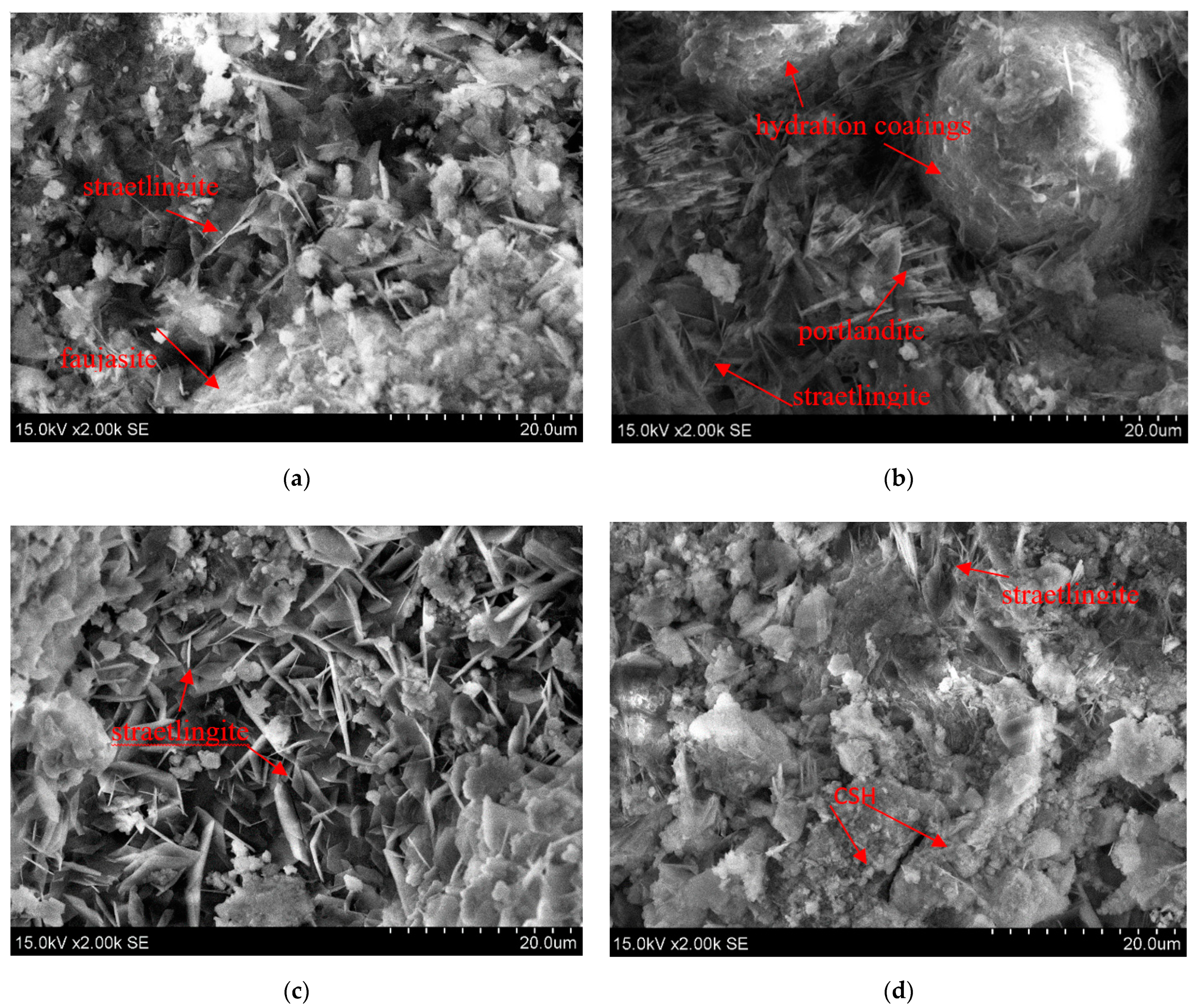
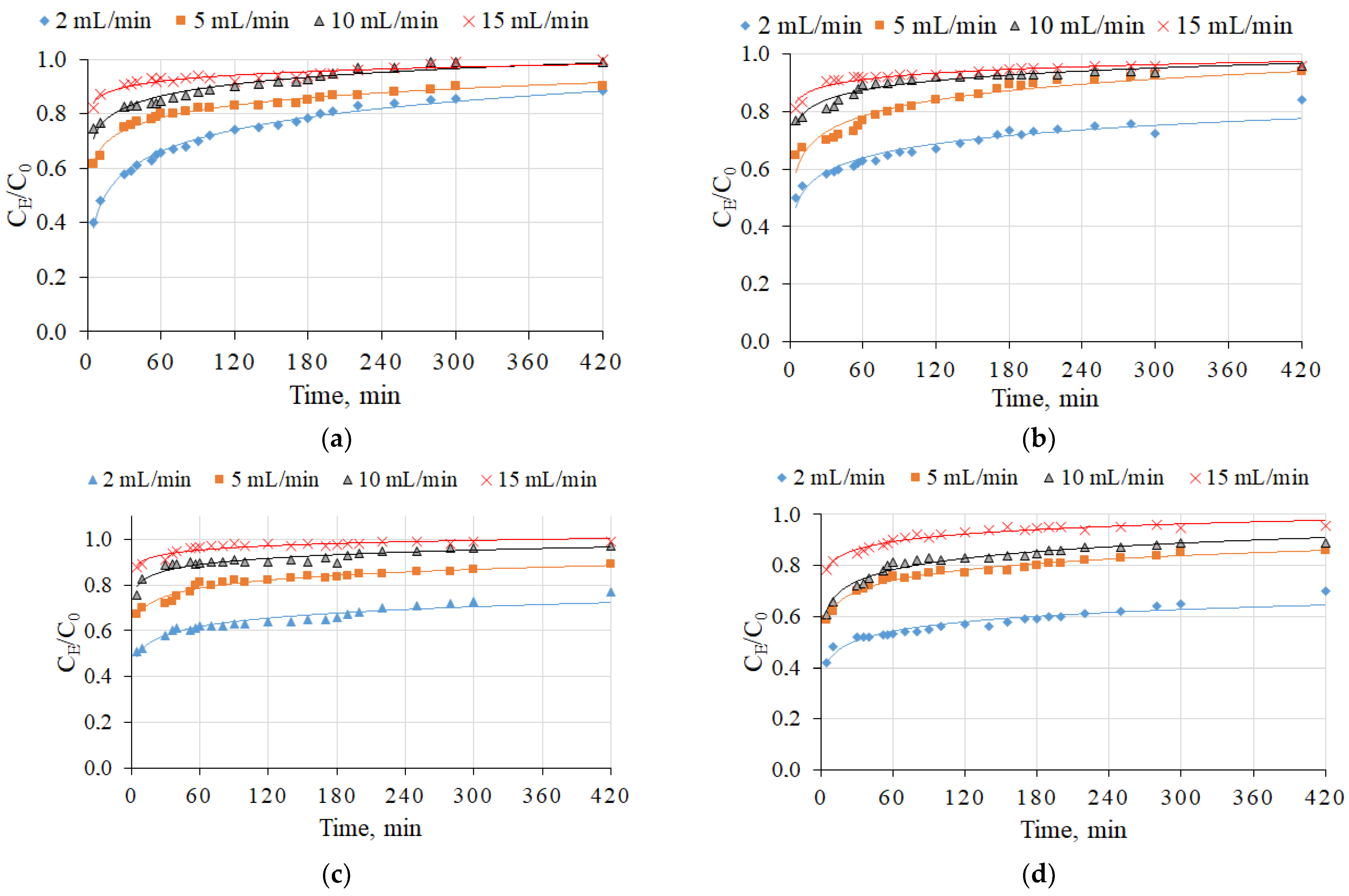
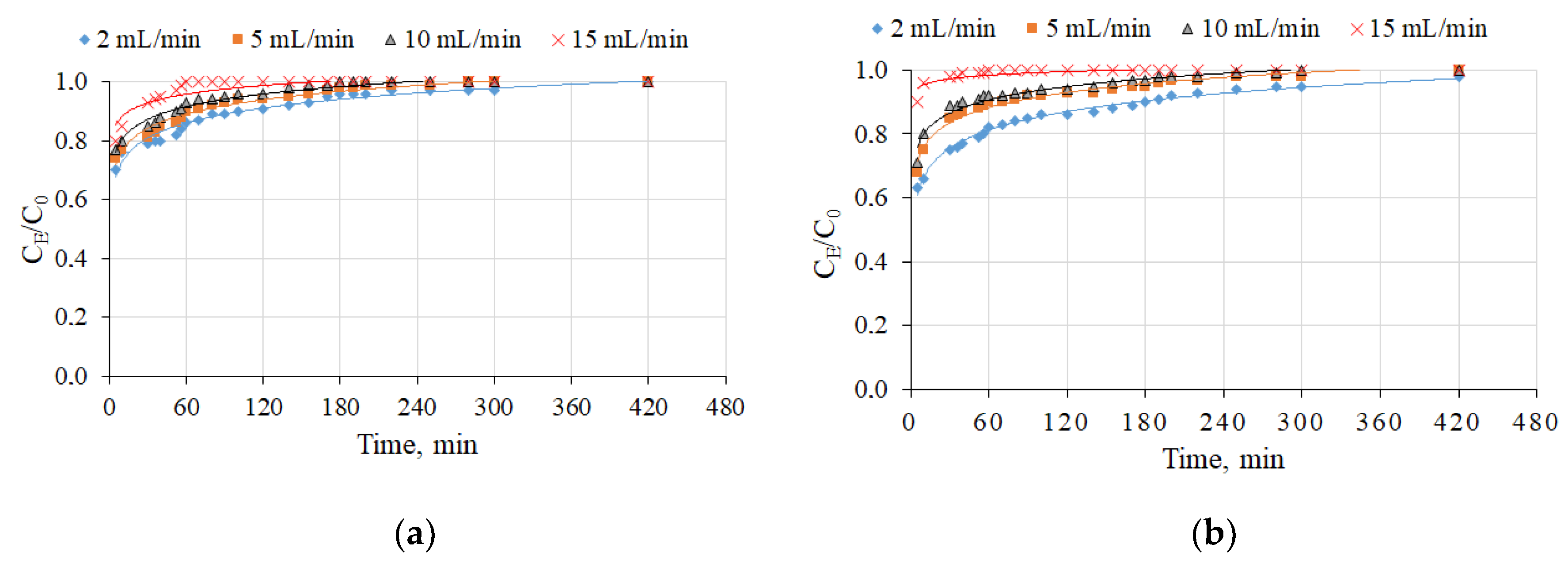

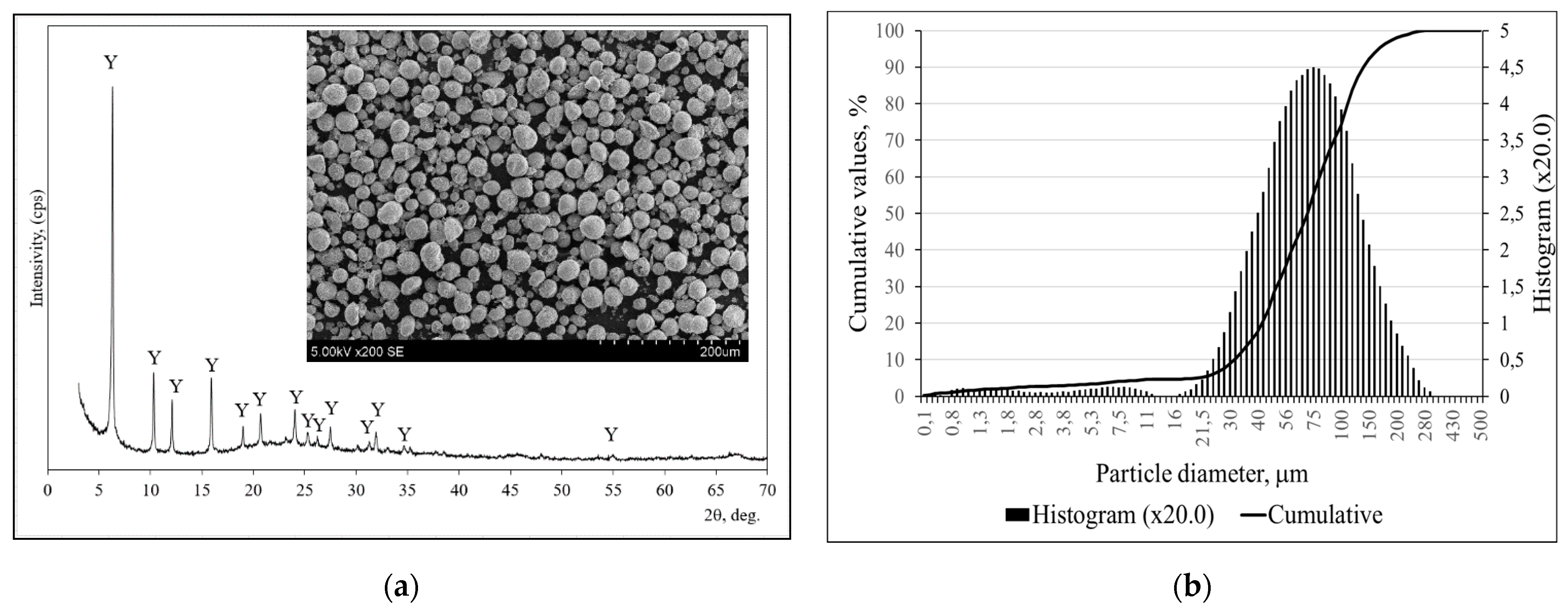
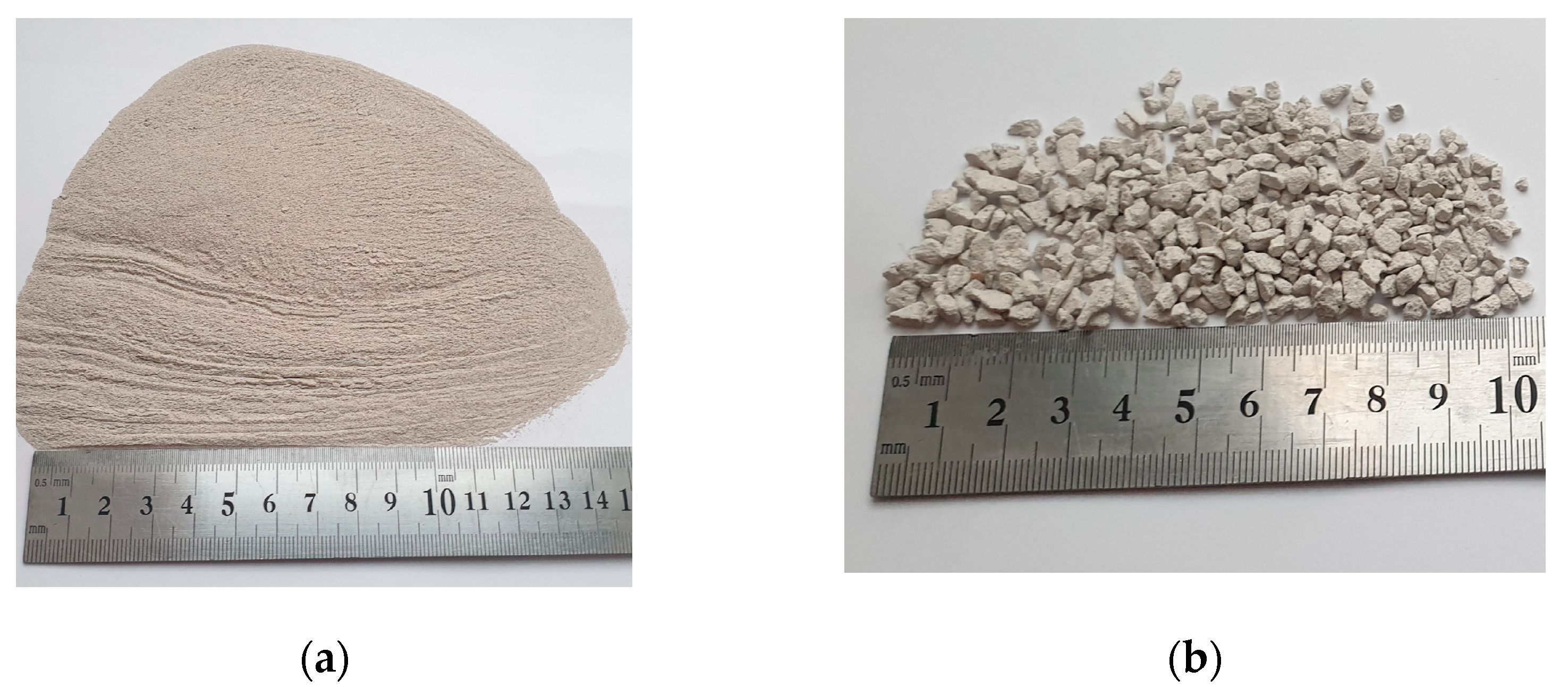
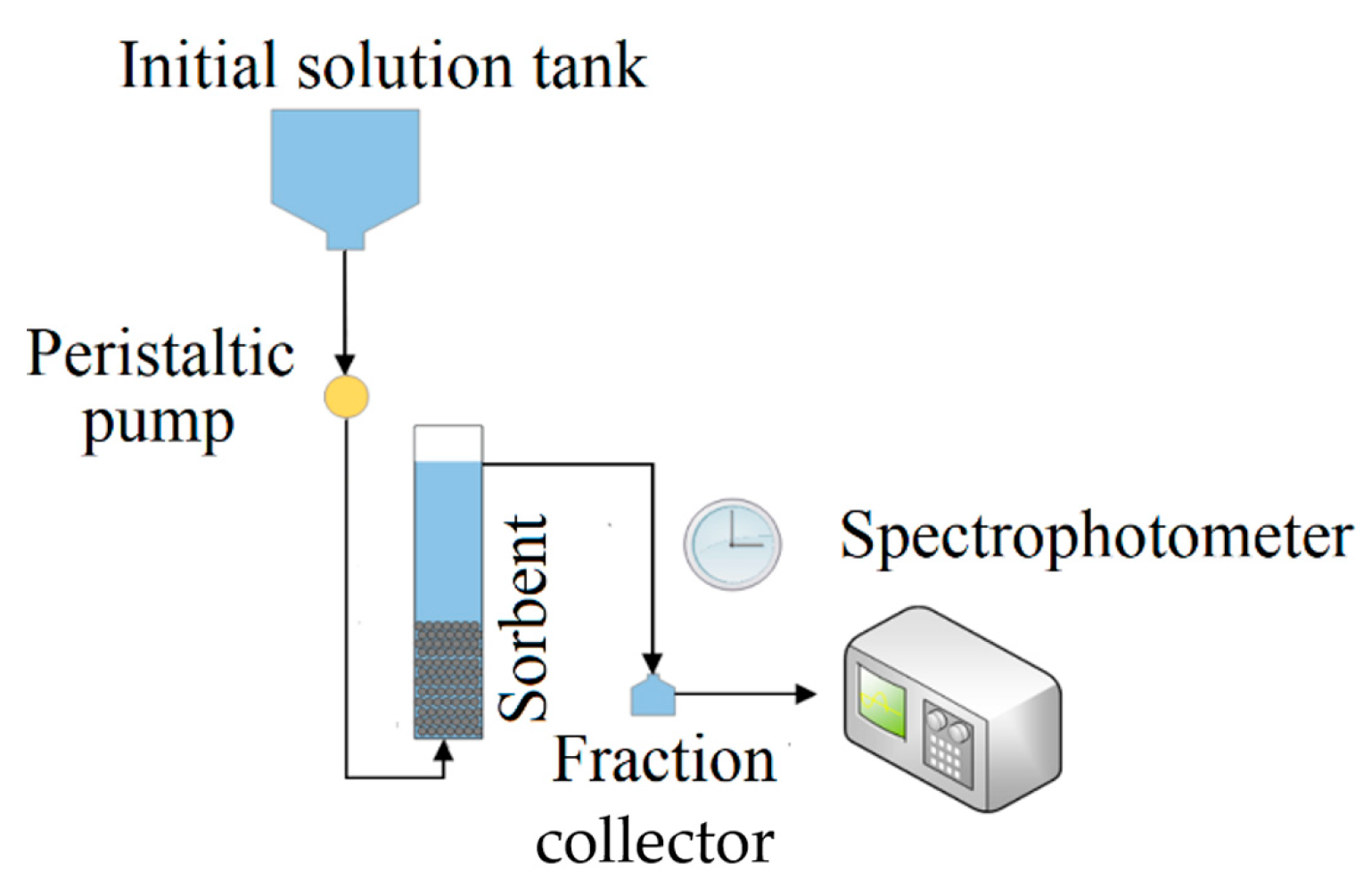
| Sorption Material | Filtration Rate, mL/min | |||||||
|---|---|---|---|---|---|---|---|---|
| 2 | 5 | 10 | 15 | 2 | 5 | 10 | 15 | |
| Breakthrough Point, min | Sorption Capacity, mg/g | |||||||
| S10 | 420 | 280 | 120 | 20 | 0.135 | 0.129 | 0.103 | 0.0446 |
| S15 | >420 * | 200 | 60 | 28 | 0.123 ** | 0.104 | 0.0694 | 0.0484 |
| S20 | >420 * | >420 * | 52 | 22 | 0.137 ** | 0.178 ** | 0.0469 | 0.0404 |
| S30 | >420 * | >420 * | >420 * | 60 | 0.169 ** | 0.215 ** | 0.341 ** | 0.0841 |
| Sorption Material | Filtration Rate, mL/min | |||||||
|---|---|---|---|---|---|---|---|---|
| 2 | 5 | 10 | 15 | 2 | 5 | 10 | 15 | |
| Breakthrough Point, min | Sorption Capacity, mg/g | |||||||
| S20 | 100 | 60 | 52 | 20 | 0.0241 | 0.0313 | 0.0489 | 0.0273 |
| S30 | 180 | 60 | 40 | 5 | 0.0255 | 0.0325 | 0.0452 | 0.0225 |
| Sorption Material | Filtration Rate, mL/min | |||||||
|---|---|---|---|---|---|---|---|---|
| 2 | 5 | 10 | 15 | 2 | 5 | 10 | 15 | |
| Breakthrough Point, min | Sorption Capacity, mg/g | |||||||
| S20 | >420 * | 250 | 262 | 120 | 0.264 ** | 0.2 | 0.341 | 0.181 |
| S30 | >420 * | >420 * | >420 * | 250 | 0.215 ** | 0.403 ** | 0.512 ** | 0.383 |
| SiO2 | Al2O3 | Fe2O3 | La2O3 | TiO2 | MgO | CaO | Na2O | Cl | P2O5 | SO3 | Other |
|---|---|---|---|---|---|---|---|---|---|---|---|
| 35.4 | 48.77 | 1.02 | 1.63 | 3.57 | 0.44 | 0.37 | 0.31 | 2.57 | 0.08 | 0.07 | 5.77 |
| Mixture | Zeolitic By-Product (wt. %) | Reagent CaO (wt. %) | Water and Solid Materials Ratio (W/S) |
|---|---|---|---|
| S10 | 90 | 10 | 0.73 |
| S15 | 85 | 15 | 0.70 |
| S20 | 80 | 20 | 0.70 |
| S30 | 70 | 30 | 0.70 |
| Parameters and Unites | Values | Parameters and Unites | Values |
|---|---|---|---|
| Oxygen saturation | >40 | NH4+, mg/L | 11.2 |
| pH | 7.6 | Nitrite, mg/L | <1.1 |
| Temperature, °C | 22 | Nitrate, mg/L | <61 |
| Free CO2, mg CO2/L | 25 | Iron, Fe, mg/L | <1.1 |
| Total nitrogen, mg/L | <1.1 | Total phosphorus, mg/L | 47.0 |
Publisher’s Note: MDPI stays neutral with regard to jurisdictional claims in published maps and institutional affiliations. |
© 2021 by the authors. Licensee MDPI, Basel, Switzerland. This article is an open access article distributed under the terms and conditions of the Creative Commons Attribution (CC BY) license (https://creativecommons.org/licenses/by/4.0/).
Share and Cite
Mikelionienė, A.; Vaičiukynienė, D.; Kantautas, A.; Radzevičius, A.; Zarębska, K. Preparation of Sorbents Containing Straetlingite Phase from Zeolitic By-Product and Their Performance for Ammonium Ion Removal. Molecules 2021, 26, 3020. https://doi.org/10.3390/molecules26103020
Mikelionienė A, Vaičiukynienė D, Kantautas A, Radzevičius A, Zarębska K. Preparation of Sorbents Containing Straetlingite Phase from Zeolitic By-Product and Their Performance for Ammonium Ion Removal. Molecules. 2021; 26(10):3020. https://doi.org/10.3390/molecules26103020
Chicago/Turabian StyleMikelionienė, Agnė, Danutė Vaičiukynienė, Aras Kantautas, Algirdas Radzevičius, and Katarzyna Zarębska. 2021. "Preparation of Sorbents Containing Straetlingite Phase from Zeolitic By-Product and Their Performance for Ammonium Ion Removal" Molecules 26, no. 10: 3020. https://doi.org/10.3390/molecules26103020
APA StyleMikelionienė, A., Vaičiukynienė, D., Kantautas, A., Radzevičius, A., & Zarębska, K. (2021). Preparation of Sorbents Containing Straetlingite Phase from Zeolitic By-Product and Their Performance for Ammonium Ion Removal. Molecules, 26(10), 3020. https://doi.org/10.3390/molecules26103020







